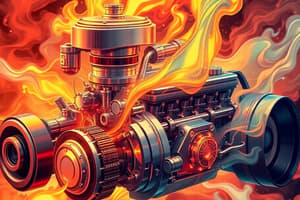Podcast
Questions and Answers
What percentage of the energy released by combustion is used to propel the vehicle?
What percentage of the energy released by combustion is used to propel the vehicle?
- 40%
- 10%
- 30%
- 20% (correct)
What is the primary component of gasoline?
What is the primary component of gasoline?
- Oxygen
- Hydrocarbons (correct)
- Nitrogen
- Carbon dioxide
What is the result of a more efficient engine?
What is the result of a more efficient engine?
- Lower exhaust emissions (correct)
- No change in exhaust emissions
- Higher exhaust emissions
- Unpredictable exhaust emissions
Why are advanced closed loop engine control systems used in modern vehicles?
Why are advanced closed loop engine control systems used in modern vehicles?
What is the purpose of understanding the combustion process?
What is the purpose of understanding the combustion process?
What are hydrocarbons composed of?
What are hydrocarbons composed of?
What can cause hydrocarbons to increase only slightly?
What can cause hydrocarbons to increase only slightly?
What has led to the increased emphasis on maintenance in modern vehicles?
What has led to the increased emphasis on maintenance in modern vehicles?
What is the trend in exhaust emission standards?
What is the trend in exhaust emission standards?
What is the result of oxygen starved combustion environment?
What is the result of oxygen starved combustion environment?
What is the normal operating condition for higher concentrations of carbon monoxide?
What is the normal operating condition for higher concentrations of carbon monoxide?
What is the reason for excessive carbon monoxide emissions?
What is the reason for excessive carbon monoxide emissions?
What is the normal operating condition for very little carbon monoxide production?
What is the normal operating condition for very little carbon monoxide production?
What is the result of high cylinder temperature and pressure during combustion?
What is the result of high cylinder temperature and pressure during combustion?
What is the principal by-product of efficient combustion?
What is the principal by-product of efficient combustion?
What can cause poor mixing of fuel and air?
What can cause poor mixing of fuel and air?
What is the primary reason for the emission of hydrocarbons in an automobile engine?
What is the primary reason for the emission of hydrocarbons in an automobile engine?
What happens to the hydrocarbon in the pores of combustion chamber deposits during combustion?
What happens to the hydrocarbon in the pores of combustion chamber deposits during combustion?
What is the most common cause of excessive hydrocarbon emissions?
What is the most common cause of excessive hydrocarbon emissions?
What occurs when the combustion flame front reaches the cool walls of the combustion chamber?
What occurs when the combustion flame front reaches the cool walls of the combustion chamber?
What happens to the air/fuel mixture during compression in the presence of combustion chamber deposits?
What happens to the air/fuel mixture during compression in the presence of combustion chamber deposits?
What is the result of a total misfire due to a shorted spark plug wire?
What is the result of a total misfire due to a shorted spark plug wire?
Why do combustion chamber deposits contribute to excessive hydrocarbon emissions?
Why do combustion chamber deposits contribute to excessive hydrocarbon emissions?
What is a common cause of misfire that can lead to excessive hydrocarbon emissions?
What is a common cause of misfire that can lead to excessive hydrocarbon emissions?
Flashcards are hidden until you start studying
Study Notes
Harmful Exhaust Emissions
- Even modern automobile engines produce some level of harmful emission output due to imperfect combustion.
- Hydrocarbon (HC) emissions occur when combustion does not take place, such as during a misfire, resulting in large amounts of hydrocarbons being emitted.
- Wall quenching, a normal process, also creates a small amount of hydrocarbon due to the cooling of the combustion chamber walls, extinguishing the flame before all fuel is fully burned.
- Combustion chamber deposits can also force hydrocarbons into pores, which are then released during the exhaust stroke.
Combustion Chemistry
- A gasoline-powered internal combustion engine releases chemical energy stored in fuel through combustion, with only 20% being used to propel the vehicle, and 80% being lost to friction, aerodynamic drag, and heat.
- Modern engines are more efficient than those of the late '60s and early '70s, but exhaust emission standards continue to tighten.
Combustion Process
- The combustion process involves the burning of gasoline, which is primarily made up of hydrocarbons (HC), chemical compounds of hydrogen and carbon atoms.
- Understanding combustion chemistry is essential for diagnosing and repairing emission control systems.
Carbon Monoxide (CO) Emission
- Carbon monoxide (CO) is a byproduct of incomplete combustion, occurring when there is insufficient oxygen present during combustion.
- CO forms when carbon atoms bond with only one oxygen atom due to an oxygen-starved environment.
- Rich air/fuel ratios, leaky injectors, high fuel pressure, and improper closed loop control can cause excessive carbon monoxide emissions.
Oxides of Nitrogen (NOx) Emission
- High cylinder temperature and pressure during combustion can cause nitrogen to react with oxygen to form Oxides of Nitrogen (NOx).
Studying That Suits You
Use AI to generate personalized quizzes and flashcards to suit your learning preferences.




